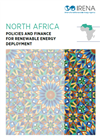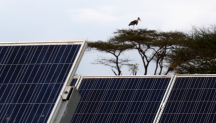

-
-
IRENA (2023), North Africa: Policies and finance for renewable energy, International Renewable Energy Agency, Abu Dhabi.
Copied
https://mc-cd8320d4-36a1-40ac-83cc-3389-cdn-endpoint.azureedge.net/-/media/Files/IRENA/Agency/Publication/2023/Dec/IRENA_North_Africa_policies_finance_RE_2023.pdf?rev=e3c4c1eb15124941a64faa70e6deb24a
Copied
North Africa: Policies and finance for renewable energy
Newsletter
North Africa – Algeria, Egypt, Libya, Morocco, Tunisia and Sudan – is the African continent’s largest energy market. The region boasts relatively high rates of socio-economic development, industrialisation and access to modern energy.
North Africa possesses significant renewable energy potential for utility-scale solar and wind power, beyond what has already been tapped. It also has decentralised, off-grid solutions set up in remote areas, and large potential markets in countries where access to electricity is limited, notably Libya and Sudan. These factors could make North Africa one of the continent’s most dynamic energy markets in the near future, including for renewable energy.
The brief by the International Renewable Energy Agency, highlights North Africa’s large renewable energy potential and explores its current policy environment to support the energy transition and the deployment of renewable energy in the coming years. It provides an overview of the region’s energy sector, including the role played by renewable energy. It also highlights the renewable energy deployment commitments of North African governments in the coming decade as well as those incorporated under energy and climate mitigation plans.
The brief outlines the evolving policy landscape for renewable energy in the region, including fiscal and financial incentives; power sector reforms; structured procurement products; and policies for the direct use of renewables in heating, cooling and transport. Focus sections explore green hydrogen and the opportunities for regional power trading. The brief explores investment and finance trends in North Africa and considers policies to prevent the most vulnerable populations from being further marginalised due to the structural transition away from fossil fuels and towards renewables.




